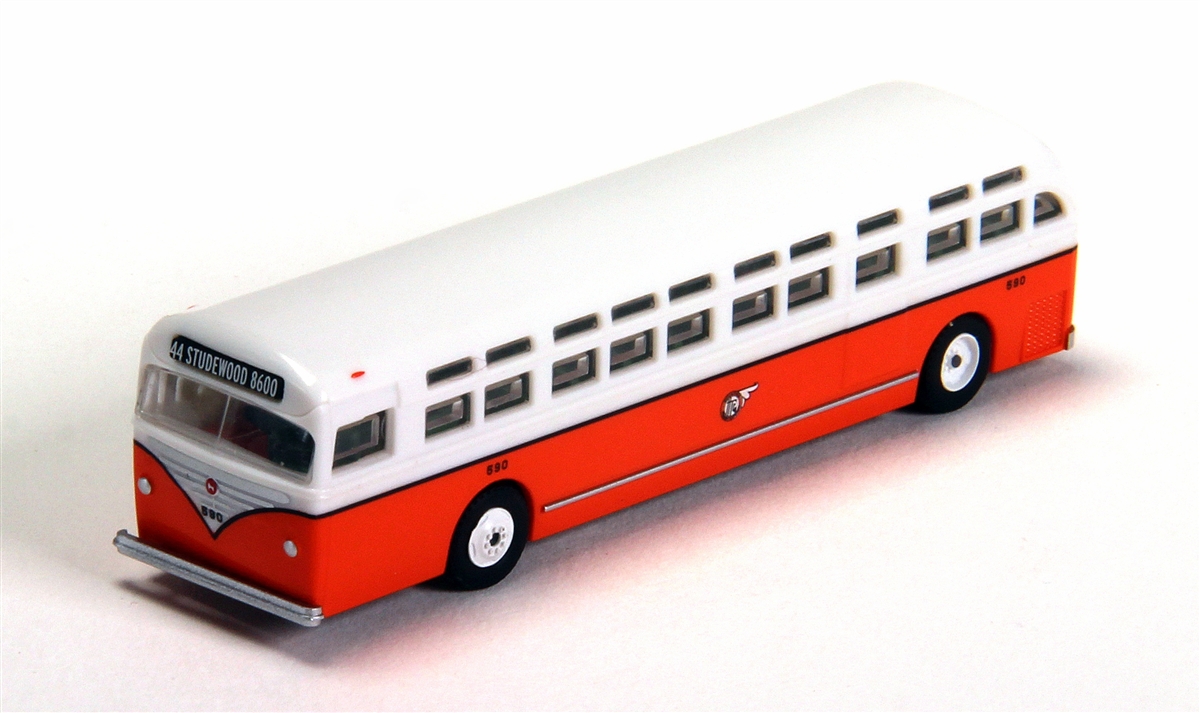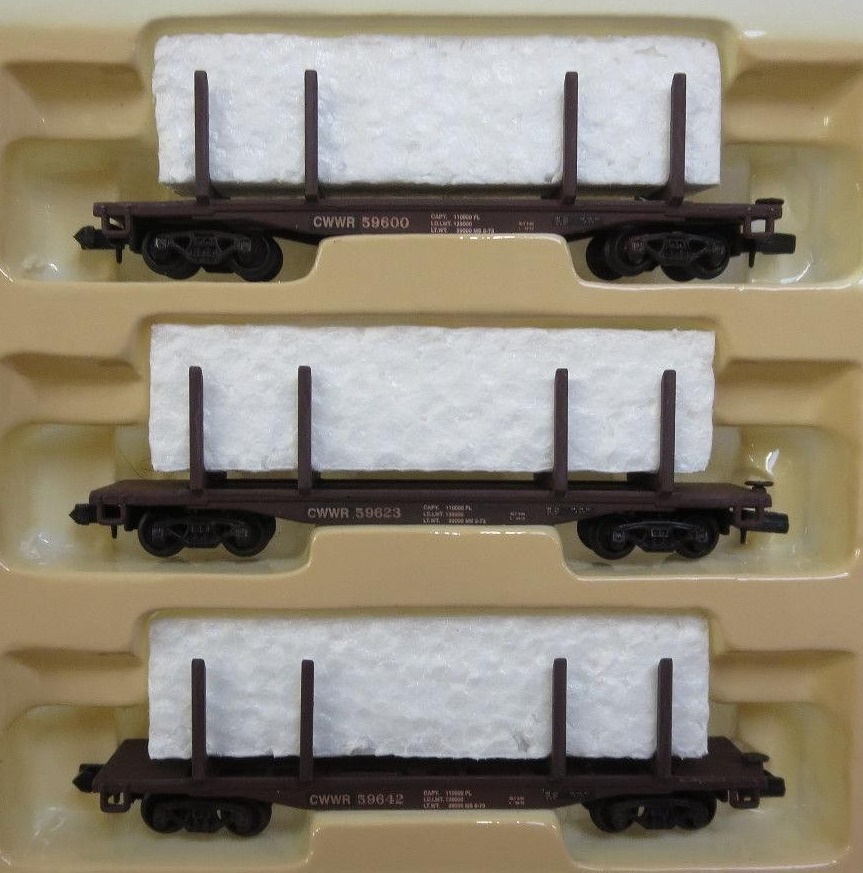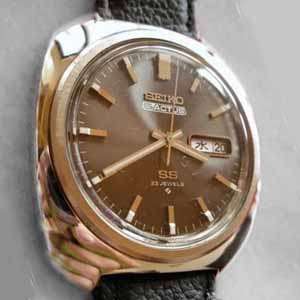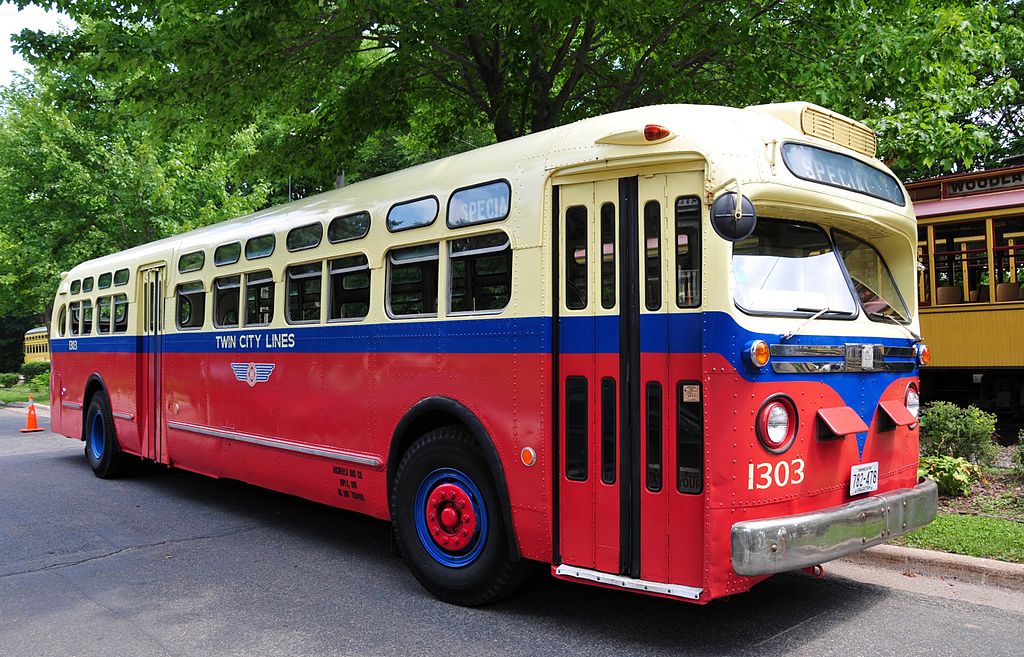Specific Item Information:
The Houston Transit Co. purchased C41-GT numbered 588 through 607 in June 1947. These C41-GT bus assignments included the Studewood line which served Southern Pacific's Grand Central Depot ( an art deco affair that was replaced by a post office) and the Heights line which served Houston's Union Station (building now an entrance to a ballpark).
The transit company itself began life as a city transit railroad operation powered by mules in 1868. The first electric trolleys arrived in 1891. By 1946, the Houston Electric Co. was renamed the Houston Transit Company (HTC). In 1961, the private owners of HTC sold the company and was renamed the Rapid Transit Lines. In 1966, it became a subsidiary of the infamous National City Lines known for replacing electric streetcars and trolleys to buses. In 1974, the City of Houston acquired the NCL's Rapid Transit Lines and renamed it to HouTran. In 1979, HouTran was superseded by the Metropolitan Transit Authority.
The transit company itself began life as a city transit railroad operation powered by mules in 1868. The first electric trolleys arrived in 1891. By 1946, the Houston Electric Co. was renamed the Houston Transit Company (HTC). In 1961, the private owners of HTC sold the company and was renamed the Rapid Transit Lines. In 1966, it became a subsidiary of the infamous National City Lines known for replacing electric streetcars and trolleys to buses. In 1974, the City of Houston acquired the NCL's Rapid Transit Lines and renamed it to HouTran. In 1979, HouTran was superseded by the Metropolitan Transit Authority.
Model Information: Model is of a GMC TDH-3610 Transit Bus. Comes with photoetched detail parts for mirror and windshield wipers. These details must be applied by the owner. The buses look fine without them but even better with them. The instructions recommend that they be applied with CA glue.
Prototype History: The GM "old-look" transit bus is a transit bus that was introduced in 1940 by Yellow Coach beginning with the production of the model TG-3201 bus. Yellow Coach was an early bus builder that was partially owned by General Motors (GM) before being purchased outright in 1943 and folded into the GM Truck Division to form the GM Truck & Coach Division. The Yellow Coach badge gave way to the GM nameplate in 1944. Production of most "old-look" models was stopped upon the release of the GM New-Look bus in 1959, however some smaller "old-look" models continued to be built until 1969. Approximately 38,000 "old-look" buses were built during the 29-year production run. The "old-look" name is an unofficial term that was applied to this series of GM buses after the release of the GM New-Look, with "New-Look" being an official term used by GM to describe their new line of buses that superseded the "old-look". This is an example of a retronym.
In 1959, GM introduced its New-Look bus with the "fishbowl" style front window, and production stopped on all "old-look" buses other than the "second-generation" models: the 28-foot (8.5 m) TGH-3102 which was built until 1963 and the 30-foot (9.1 m) 35xx models which were built until 1969.
From Wikipedia
In 1959, GM introduced its New-Look bus with the "fishbowl" style front window, and production stopped on all "old-look" buses other than the "second-generation" models: the 28-foot (8.5 m) TGH-3102 which was built until 1963 and the 30-foot (9.1 m) 35xx models which were built until 1969.
From Wikipedia
Brand/Importer Information: Wheels of Time was founded by Matthew Young in the fall of 1995. From an early age, Matthew has had a passion for trains, both in full-size and in miniature. His family frequently went out of their way so he could ride the train, or simply watch the action on the tracks. "On one occasion mom took us to San Francisco along the waterfront. Spotting a State Belt ALCo S-2 locomotive switching the wharves, I persuading my mom to follow it. I watched in wonder as I saw and heard the hit-cup sputtering of the ALCo engine as it revved-up to move railroad cars on and off the car float at Pier 43." Other early family experiences included watching Southern Pacific freight and Amtrak's San Joaquin Amfleet trains roll by as his family waited to be seated at Spenger's in Berkeley, which sat happily right next to the tracks. "My brother and I would shoot pictures of the trains with our Instantmatic 110 cameras, sometimes only getting the wheels or worse yet ... getting a real good close up of my big thumb."
Matthew and his brother built models of all kinds, but their model train career began in elementary school when they started making 3-D cardboard miniature trains from pictures found in the pages of Trains Magazine and Model Railroader Magazine. On a visit, many years later, with the late Richard Buike of Trackside Trains in Burlingame, California, the conversation turned to the lack of N-Scale passenger trains and how the few that existed didn't look right. "I told him right then and there that I was going to produce high quality, historically accurate passenger railroad cars. Even I was a little surprised when I said this." The first product was a 1950 Pullman-Standard "10-6" sleeping car made of brass. Wheels of Time became one of the first makers of historically accurate and realisticly detailed passenger train cars. At Wheels of Time, we research original equipment and recreate it with CAD software for production. We're lovers of history and sticklers for detail. On our line of Transit Motor Coaches (a fancy way of saying "buses"), even the destination *roll* signs are historically accurate. Be sure to check out all our beautiful and accurate products. We hope you'll come to share our passion for trains, here recreated in miniature. At Wheels of Time, you get to take home a piece of a fascinating history.
Wheels of Time manufactures historically accurate model trains, vehicles, and model railroad accessories with a real *wow* factor. Our obsession with detail and historical accuracy is reflected in our exceptional design and production: hold a Wheels of Time model in your hand and you'll be tempted to say, 'It's the real thing!'
Matthew and his brother built models of all kinds, but their model train career began in elementary school when they started making 3-D cardboard miniature trains from pictures found in the pages of Trains Magazine and Model Railroader Magazine. On a visit, many years later, with the late Richard Buike of Trackside Trains in Burlingame, California, the conversation turned to the lack of N-Scale passenger trains and how the few that existed didn't look right. "I told him right then and there that I was going to produce high quality, historically accurate passenger railroad cars. Even I was a little surprised when I said this." The first product was a 1950 Pullman-Standard "10-6" sleeping car made of brass. Wheels of Time became one of the first makers of historically accurate and realisticly detailed passenger train cars. At Wheels of Time, we research original equipment and recreate it with CAD software for production. We're lovers of history and sticklers for detail. On our line of Transit Motor Coaches (a fancy way of saying "buses"), even the destination *roll* signs are historically accurate. Be sure to check out all our beautiful and accurate products. We hope you'll come to share our passion for trains, here recreated in miniature. At Wheels of Time, you get to take home a piece of a fascinating history.
Wheels of Time manufactures historically accurate model trains, vehicles, and model railroad accessories with a real *wow* factor. Our obsession with detail and historical accuracy is reflected in our exceptional design and production: hold a Wheels of Time model in your hand and you'll be tempted to say, 'It's the real thing!'
Item created by: gdm on 2016-10-03 09:16:25. Last edited by gdm on 2016-10-03 09:19:13
If you see errors or missing data in this entry, please feel free to log in and edit it. Anyone with a Gmail account can log in instantly.
If you see errors or missing data in this entry, please feel free to log in and edit it. Anyone with a Gmail account can log in instantly.










